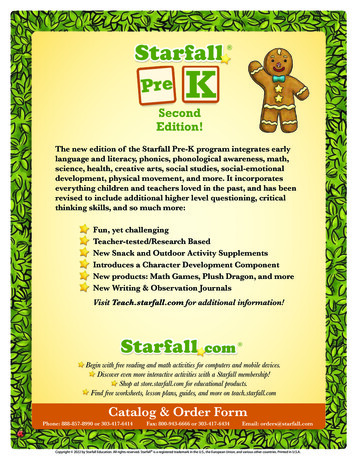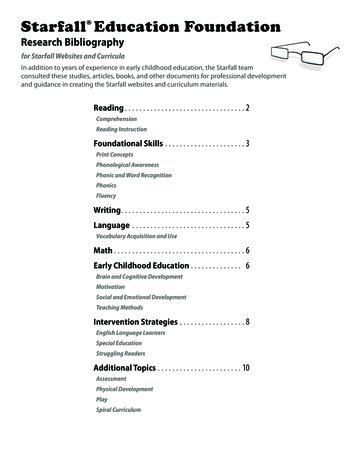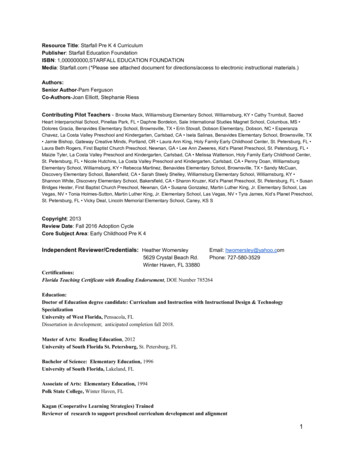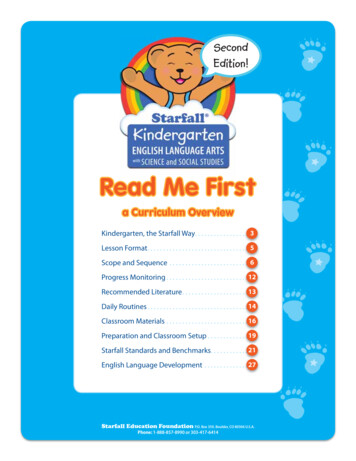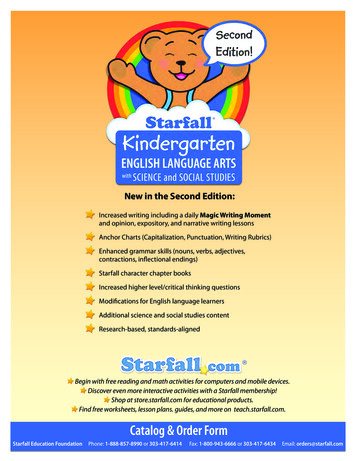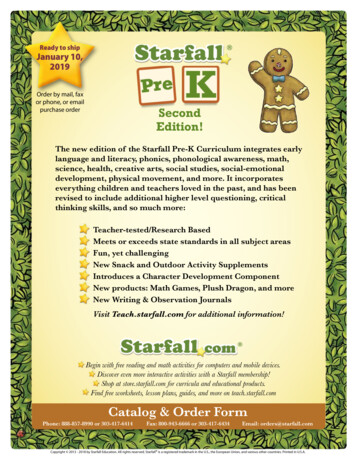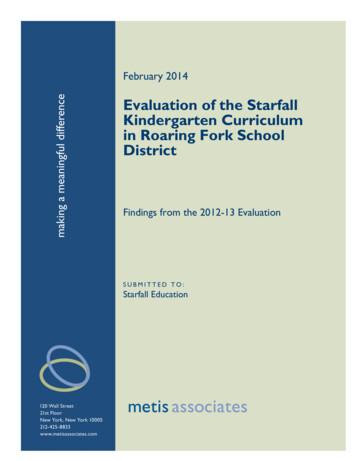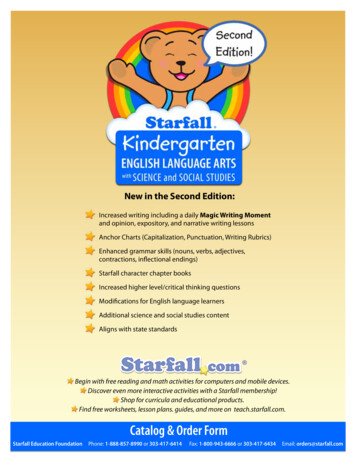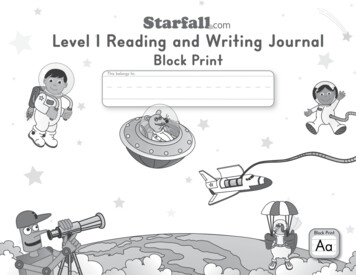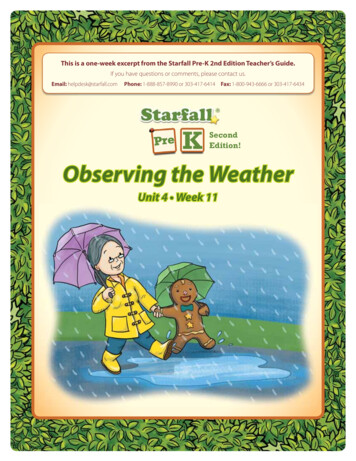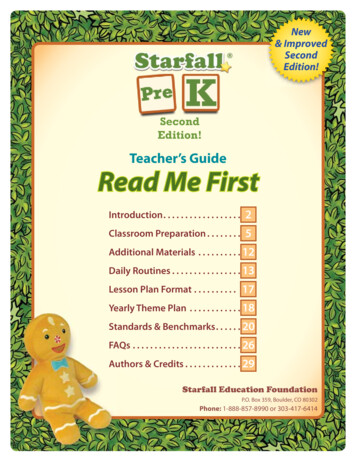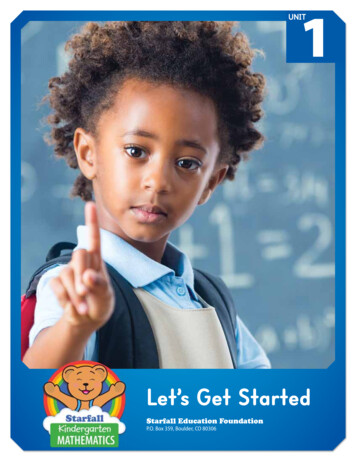
Transcription
UNIT1Let’s Get StartedStarfall Education FoundationP.O. Box 359, Boulder, CO 80306
Starfall Education Foundation P.O. Box 359, Boulder, CO 80306 U.S.A.Email: helpdesk@starfall.com2UNIT 1Phone: 1-888-857-8990 or 303-417-6414Fax: 1-800-943-6666 or 303-417-6434
UNIT11Let’s Get StartedUnit 1 OverviewFrequently Asked Questions . . . . . . . . . . . . . . . . . . . . . . . . . . . . . . . 4Research . . . . . . . . . . . . . . . . . . . . . . . . . . . . . . . . . . . . . . . . . . . . . . . 5Unit 1 Summary. . . . . . . . . . . . . . . . . . . . . . . . . . . . . . . . . . . . . . . . . 6Standards & Benchmarks . . . . . . . . . . . . . . . . . . . . . . . . . . . . . . . . . 8Week 1Summary & Preparation . . . . . . . . . . . . . . . . . . . . . . . . . . . . . . . . . 10Introduce Daily Routines and Preview the Number One. . . . . . . 15Review One, Preview Two . . . . . . . . . . . . . . . . . . . . . . . . . . . . . . . . 18Preview Three. . . . . . . . . . . . . . . . . . . . . . . . . . . . . . . . . . . . . . . . . . 21Preview Four. . . . . . . . . . . . . . . . . . . . . . . . . . . . . . . . . . . . . . . . . . . 24Preview Five . . . . . . . . . . . . . . . . . . . . . . . . . . . . . . . . . . . . . . . . . . . 27Week 2Summary & Preparation . . . . . . . . . . . . . . . . . . . . . . . . . . . . . . . . . 30Explore Shapes . . . . . . . . . . . . . . . . . . . . . . . . . . . . . . . . . . . . . . . . . 35AB Patterns . . . . . . . . . . . . . . . . . . . . . . . . . . . . . . . . . . . . . . . . . . . . 38Introduce Octagon and Review Two-Dimensional Shapes . . . . . 41Pattern Review. . . . . . . . . . . . . . . . . . . . . . . . . . . . . . . . . . . . . . . . . 44Count Backward to Zero . . . . . . . . . . . . . . . . . . . . . . . . . . . . . . . . . 47UNIT 13
Frequently Asked QuestionsWhat is the primary focus of theStarfall math curriculum?Number sense is the primary focus of the StarfallMath curriculum. Number sense is the foundationfor children’s later mathematical achievement.Many preschool children can mechanically count,or even add and subtract as a result of practiceand drill, yet they hardly understand the meaningof numbers or their relationships. In other words,children “do” math without understandingnumbers. The Starfall Math curriculum focuseson number sense, involving the understandingof whole numbers, number operations, andnumber relations. In order to navigate formalmathematics, children must be able to link theirbasic understanding of numbers to symbolicrepresentations. Early number competenciesinfluence future success in mathematics. Asnumber sense is being developed, geometry,algebraic reasoning, and measurement areintegrated and spiraled throughout the curriculum.Why is the Daily Morning Routine soimportant?The Daily Morning Routine includes the followingfive components, which demonstrate the useof numbers in everyday life and provide dailyexposure to cardinality.1. Calendar Routine — The Calendar Routineprovides practice in ordering numbers, readinga graph, adding “one more,” creating equivalentsets, ordinal numbers, coin values, and the listgoes on!2. Weather Routine — The Weather Routineprovides experience with a different wayto graph numbers through the use of tallymarks. Children learn and practice predicting,estimating, greater than, less than, equal, andprobability as they chart the daily weather.4UNIT 13. Number Line Routine — The NumberLine Routine establishes, at an early age, thatnumbers do not begin at zero but are infinitein both directions (positive and negative). Thepremise is that children will use the number lineas one way to chart how many days they havebeen in school. Its uses are unlimited: countingforward from a given number; countingbackward from a given number; skip countingby 2s, 5s, 10s, 25s, 50s; ordering numbers; andadding one more.4. Place Value Routine — The Place ValueRoutine is linked to the Number Line Routine,and is probably the single most importantroutine in which children learn from a veryyoung age that our number system containsonly the digits 0 through 9 and that regroupingis necessary to form additional numbers.Children “bundle” every ten days, which helps toset the stage for understanding place value.5. Hundreds Chart — The Hundreds Chart alsoreinforces number order and intuitively createsa visual that demonstrates how numbersare organized by groups. It provides anotherexperience in charting numbers.
Unit 1 ResearchAs young children learn to describe and representquantities, shapes, space, and patterns, they gaininsights and ideas for understanding the world.Evidence shows that learning mathematics is vitalfor children’s early years and for later success inmathematics, as well as increased overall academicsuccess in such areas as literacy, science, andtechnology.(1) Starfall Math is designed to helpchildren see relationships and interconnectionsin mathematics. Each unit is a building block forfuture units.In 2006, NCTM (National Council of Teachers ofMathematics) released Curriculum Focal Points forpre-kindergarten through grade 8 mathematics.At the kindergarten level, the three focal pointsinclude numbers and operations, geometry, andmeasurement.(2) It is crucial that sufficient time isdevoted to mathematics instruction in kindergartenso that children develop the foundationalmathematical skills and understanding describedhere. Time must be allocated not only for themore formal parts of mathematics instructionand discussions that occur in the whole group orsmall groups, but also for children to elaborateand extend their mathematical thinking byexploring, creating, playing in learning centers, andcompleting computer activities.(3) Effective wholegroup interactions include brief demonstrationsand discussions, problem solving in which childrenpartner to talk and work together, and physicallyactive activities such as marching around the roomwhile counting, acting out nursery rhymes thatinclude counting, and acting out patterns and graphs.Children in a Starfall Math classroom learn thatwith the combination of only 10 numerals (0through 9), they can write any number, nomatter how large. They begin to understand thatthe meaning of a numeral in a written numberdepends in a very specific way on its placement.They actively participate in creating larger andlarger units of numbers by bundling them togetherto create groups of 10.Research reveals that the use of open-endedquestions increases math talk in the classroom.Effective teachers ask children “Why”? and “Howdo you know?” (4) Starfall’s Magic Math Momentand math lessons provide experiences that allowchildren to share strategies, explain their thinking,work together, and listen to each other tosolve problems.Morning math routines, in which students gathertogether on a rug or carpet to interact, helpenhance math instruction.(5) The activities aredesigned to build number sense in students,therefore it is important that students are incontrol and have the opportunity to demonstratetheir understanding and proficiency in numberoperations. Posting the date on the calendar,adding a craft stick to count school days, predictingthe day’s weather, and other similar activities helpchildren develop real-life math skills and reinforcethe base ten number system throughout the 180days of the school year.(1) Duncan, G.J., Dowsett, C.J., Claessens, A., Magnuson, K., Huston, A.C.,et al, (2007). “School Readiness and Later Achievement,” DevelopmentalPsychology, 43(6), 1428-1446.(2) National Council of Teachers of Mathematics (2006). Curriculum FocalPoints for Pre-Kindergarten through Grade 8 Mathematics: A Quest forCoherence. Reston, VA.(3) Committee on Early Childhood Mathematics (2009). MathematicsLearning in Early Childhood: Paths toward Excellence and Equity.Washington, D.C.: National Academies Press.(4) Clements, D.H., and Sarama, J. (2007). Early childhood mathematicslearning. In F.K. Lester, Jr. (Ed.), Second Handbook of Research onMathematics Teaching and Learning (pp. 461-555). New York, NY:Information Age.(5) McCoy, A., Barnett, J., and Combs, E., (2013). High-Yield Routines forGrades K-8. National Council of Teachers of Mathematics.UNIT 15
Unit 1 SummaryTime Frame: 10 daysThe children will become acquainted with the Gathering Routine, which incorporates the monthly calendar,weather prediction, number line, place value, and hundreds day chart. The Gathering Routine is a keycomponent of the Starfall Math Program and will be used daily. This routine must begin on the first dayof school. In Week 2, the children will become better acquainted with the Gathering Routine. They willlearn about creating and extending simple patterns and continue their study of geometric shapesand their attributes.Essential QuestionsEnduring Understandings(K.CC.B.5) How can counting objects help meknow how many there are?Numbers have names and we can use them to count.(K.OA.A.2) What strategies can we use to solveword problems?Almost everything can be counted. Number namestell us how many objects are in groups and allow usto count in order and compare groups of objects.(K.MD.A.2) How can we use measurement todescribe and compare objects?Objects can be similar to others in one way anddifferent in other ways.(K.G.B.4) How can we compare shapes?Subtracting is taking groups apart and making less.When measuring, you start at the beginning of theobject and finish measuring at the end of the object.When comparing two lengths, one end of eachlength must match.VocabularyThe children will be introduced to these vocabulary words. Mastery is not expected at this time.6AngleHexagonPartnersSquareCalendarHundreds chartPatternStraight lineCircleNegative numberPentagonTally markCurved lineNumberRectangleTriangleEllipseNumber lineRhombusTwo-dimensionalGraphOctagonRuleZeroUNIT 1
Recommended LiteratureChicka Chicka 123 by Bill Martin, Jr. and Michael SampsonCounting Crocodiles by Judy Sierra and Will HillenbrandFive Little Monkeys Jumping on the Bed by Eileen ChristelowMouse Shapes by Ellen Stoll WalshRound Is a Tortilla: A Book of Shapes by Roseanne Greenfield Thong and John ParraUNIT 17
Standards & BenchmarksProgress on the following standards and benchmarks will be made through the course of this unit. For yourconvenience, applicable learning outcomes are listed alongside each lesson in summary form.Starfall StandardsCounting & CardinalityOperations & Algebraic ThinkingCC.3 Count backward from a given number.OA.1 Identify, describe, or extend simple patterns.Common Core StandardsCounting & CardinalityA.2 Count forward beginning from a given number within the known sequence (instead ofhaving to begin at 1).B.4 Understand the relationship between numbers and quantities;connect counting to cardinality.B.4a When counting objects, say the number names in the standard order, pairing each object withone and only one number name and each number name with one and only one object.B.4b Understand that the last number name said tells the number of objects counted.The number of objects is the same regardless of their arrangement or the order in whichthey were counted.B.4c Understand that each successive number name refers to a quantity thatis one larger.Operations & Algebraic ThinkingA.1 Represent addition and subtraction with objects, fingers, mental images, drawings, sounds(e.g., claps), acting out situations, verbal explanations, expressions, or equations.Measurement & DataA.1 Describe measurable attributes of objects, such as length or weight.Describe several measurable attributes of a single object.A.2 Directly compare two objects with a measurable attribute in common, to see which objecthas “more of”/“less of” the attribute, and describe the difference. For example, directlycompare the heights of two children and describe one child as taller/shorter.GeometryCount forward froma given number.Understand therelationship betweennumbers and quantities.Say number names inorder, pairing each objectwith one number.The last numbercounted tells the totalnumber of objects.Each successive numberrefers to one more.Inline Summary FormRepresent additionand subtraction ina variety of ways.Inline Summary FormDescribe measurableattributes of objects.Compare two objectswith a commonmeasurable attribute.Inline Summary FormA.2 Correctly name shapes regardless of their orientations or overall size.Correctly name shapes.A.3 Identify shapes as two-dimensional (lying in a plane, “flat”) or three-dimensional (“solid”).Identify shapes as twoor three-dimensional.B.4 Analyze and compare two- and three-dimensional shapes, in different sizes and orientations,Analyze and comparetwo- and threedimensional shapes.using informal language to describe their similarities, differences, parts (e.g., number of sidesand vertices/“corners”) and other attributes (e.g., having sides of equal length).8Inline Summary FormUNIT 1
9875032164UNIT 19
UNIT 1WEEK1Week 1 SummaryThe children will become acquainted with the Gathering Routine, which incorporates themonthly calendar, weather prediction, number line, place value, and hundreds day chart.The Gathering Routine is a key component of the Starfall Math Program and will be useddaily. This routine must begin on the first day of school. The children will also: Learn how to observe, predict, and chart the weather Be introduced to the concept of place value Practice counting using the number line Explore negative numbers and number concepts Learn about basic shapes and their attributes Measure using rectangular lengths Become familiar with cooperative learning activitiesClassroom PreparationPrepare a blank classroom calendar for the month and have the name of the month anddays and the numerals 1 to 31 available. Do not assemble the calendar. The children willdo this together.1111111Mount the -5 to 180 Classroom Number Line111around the classroom where it is easilyobservable. Cover each number above zero with a sticky note.1111 111Display the Weather Picture Cards attached tochart paper or on a whiteboard, arranged toallow a space to draw tally marks under each.11Prepare a hundreds day chart by placing numbered cards from 1 to 100 face down in the chart.The children will turn a card each day to gradually reveal all 100 numbers in sequence.Have rubber bands and a container of sticks, stirrers, craft sticks, or strawsavailable. Label three containers to create a ones container, a tens container, and ahundreds container.Be prepared to introduce Backpack Bear to the children. He will be a member of the classfor the year.Please refer to the Math Read Me First for further information regarding classroom setup.10UNIT 1
UNIT 1DAY 1WEEK 1Duplicate a copy of the “Actions for the Number One” blackline.Cut the actions apart and place them in a paper bag.DAY 2Actions for the Number OneHave a ruler and a large construction paper circle and ellipse available.You will use the circle throughout the week.Prepare the two sentence strips pictured at right. You will use them on Day 2and again on Day 3.Familiarize yourself with the partner sharing strategy onpage 19 of the lesson plans. You will use this strategytoday and throughout the school year.This is a.I know this because.The children will listen to Math Melodies CD Track 3,“Circle Song.”DAY 3Prepare a large construction paper triangle. You will use it throughout the week.Distribute a math bag to each child. Each child will also need a circle and a triangleattribute block. When the lesson is finished, the children will place the attribute blocksin their math bags.Familiarize yourself with the “Rocket Cheer.” The children place both handstogether near their waists with palms together and fingers pointed up. They wiggle theirhands upward like a rocket taking off. When the children’s hands reach over their heads,they separate them in a big circular movement, like bursting fireworks, while saying, “Ah!”DAY 4Prepare a large construction paper rectangle and square. You will use them with thecircle, ellipse, and triangle prepared earlier in the week.You will also need a square and a rectangle attribute block for each child. The childrenwill add them to their math bags when the lesson is finished.DAY 5Prepare sets of six construction paper rectangles in varying lengths (all the same color).The six lengths should consist of three pairs of the same length to be used in a matchingactivity. Laminate them for future use. You will need one rectangle for each child.You will need a large construction paper square, rectangle, rhombus, and pentagonfor demonstration purposes.UNIT 111
UNIT 1WEEK1Daily RoutinesDAY 1DAY 2IntroduceCalendarCalendarWeatherWeatherNumber LineNumber LineBuild a CalendarThe number oneIntroduceIntroduceTally marksMath ConceptsThe circle, the ellipse, andtheir propertiesNegative numbersPreview the number twoPlace valueHundreds Day ChartPreview the number oneActions corresponding tonumbers 1-5Formative /SummativeAssessment1IntroducePartner sharingMath Melodies CD Track 3,“Circle Song”Workbooks& Media12UNIT 112
UNIT 1WEEK 1DAY 3DAY 4DAY er LineNumber LineNumber LinePlace ValuePlace ValuePlace ValueHundreds ChartHundreds ChartHundreds ChartPreview the number threeIntroduce3The triangle and its propertiesPreview the number fourIntroduce4The rectangle, the square,and their propertiesPreview the number fiveReview rectangle/square5IntroduceThe pentagon, the rhombus,and their propertiesMeasuring length usingrectanglesMeasuring (Matching Game)Review circle and triangleReview shapesDiscuss measuring activityPartnersIntroduceThe Rocket CheerUNIT 113
WEEK 1DAY1Counting &CardinalityB.4 – Understand therelationship betweennumbers and quantities.B.4a – Say numbernames in order,pairing each objectwith one number.B.4b – The last numbercounted tells the totalnumber of objects.B.4c – Each successivenumber refers toone more.DailyRoutinesCalendarAsk: Why do people use calendars? Volunteersrespond. Yes, people use calendars for many reasons.Why might we use a calendar in our classroom?Volunteers respond.MaterialsF Computer navigatedto Starfall.com:CalendarF Classroom CalendarF Name of month anddays, numbers 1-31Say: Let’s build our own calendar. Indicate the blankclassroom calendar. Who knows what’s missing?On a classroom computer, access Starfall.com: Calendar. View the month (firstscreen) and the days of the week (second screen). Lead the children to noticethese are missing from the classroom calendar, and then add them.Ask: What else is missing? Right, the numbers!Distribute numbers 1–31 (depending on the current month) to the children.The children place their numbers onthe classroom calendar. Say: (currentmonth) has (number of days) days.Today is (month, date).Continue: Let’s turn over all ofthe number cards for the days in(current month) ahead. Now ourcalendar tells us today’s date: (day,month, date).Weather Indicate the Weather Picture Cards and help thechildren identify them.MaterialsF Weather PictureCards (displayed) Introduce tally marks as a way to keep track of the number of objects. Demonstrate how to make a tally mark under “Today’s Weather.”14UNIT 1
MaterialsNumber LineReview the numbers on the calendar. Call the childrenby name and direct them to form a “human number line”by standing shoulder-to-shoulder. Touch each child’shead as you count them. Say: We just madea number line!UWD111F Whiteboard, markerF Number line(mounted)F PointerIndicate the Classroom Number Line on the wall. Say: This is ournumber line. What do you notice? (Some numbers are covered.)Yesterday we were not in school. We had been in school negativeone days.Indicate the negative numbers. Say: Look at these numbers.These are negative numbers. That means these numbers comebefore zero. Yesterday was (dayof the week). We were not inschool. We had been in schoolnegative one days. The daybefore that was (name the day).We were in school negative two days.The day before that we were in schoolnegative three days.The children are notexpected tounderstandnegative numbers at thistime, but itis importantforchildren tounderstandthatour number system doesnot begin with zero. Itisinfinite. Briefly introducingnegative numbers helpschildren begin to seethis.Say: Let’s look at zero again. Whatnumber comes after zero? Remove thesticky note to reveal the number one.Continue: Zero is a placeholder betweenthe negative numbers and the positivenumbers. Each day we are in school wewill reveal a new positive number.MaterialsIntroduce Daily Routinesand Preview One1 Introduce Place Value RoutineF Prepared “Actions for the NumberOne” strips in a paper bagF Prepared Hundreds ChartF Three containers (labeled1s, 10s, 100s)F Whiteboard, markerF Container of craft sticksCounting & CardinalityB.4 – Understand therelationship betweennumbers and quantities.Indicate the container of craft sticks and the ones, tens,and hundreds containers. Explain: Each day we are inschool we will place a stick in one of these containers.B.4a – Say numbernames in order,pairing each objectwith one number.Indicate the ones container. Say: This container is for individual sticks, but it canonly hold nine sticks. On our tenth day of school we will bundle the tensticks and place them in the next container.B.4b – The last numbercounted tells the totalnumber of objects.Indicate the Classroom Number Line and point to zero. Say: Yesterday we hadbeen in school negative one days. Look at this number. Indicate negative one.This is negative one. Say negative one. Children repeat, negative one.B.4c – Each successivenumber refers toone more.UNIT 115
UWD111Continue indicating negative numbers. Say: This was the day before yesterday(negative two). This was the day before that (negative three).Ask: Who can find the number that comes after zero? (one) This number tellsus how many days we have been in school so far, so we will put one stickin the container to match the number of days we have been in school.A volunteer places the stick in the ones container.2 Introduce the Hundreds Day ChartSay: Here is another way to count how many days we’ve been in school.It’s our Hundreds Day Chart. We will turn one number each day.A volunteer turns the first number.3 Preview the Number OneWrite the numeral 1 on the whiteboard. Ask: Who can find all the number onesin our classroom? (calendar, number line, hundreds chart, clock, etc.)Accept and affirm correct responses.Say: I can find another way to show one. There is one tally mark undertoday’s Weather Card. Where else do you see a way to show one?(There is one stick in the ones container.)Actions for the Number OneBackpack Bear whispers that there is only ONE of him!Formative AssessmentAction Strips for the Number OneIndicate the paper bag containing theaction strips for the number one.Choose a volunteer to draw a stripfrom the bag. Read the action (jump,clap, nod, turn around, wiggle, blink,smile, wink, hop, wave, yawn) andtogether the class performs it onetime. Choose additional volunteersand repeat as time allows.16UNIT 1See the Read MeFirst to learn aboutBackpack Bear andhow to incorporatehim as a memberof your class.
DailyWEEK 1RoutinesCalendarSay: This is the calendar we built yesterday.Indicate the month. The name of the month is(current month). Say, (current month).DAYMaterialsF Computer navigatedto Starfall.com:CalendarF Classroom CalendarF Name of month anddays, numbers 1-31Say: Let’s say the names of the days of the week together.Indicate and name the days. If yesterday was (yesterday’sname), what is the name of the day that comes after (yesterday’s name)?Say: Let’s count how many days there have been in (current month) so far.Point to and count from one to the present date. Explain: Each day thecalendar helper will reveal one more day. The calendar helper turns thenext number to reveal the next day. Say: Today is (day, month, date).WeatherSay: Here are pictures of different kinds of weather.Yesterday was (yesterday’s weather). I wonder whatkind of weather we will have today.2MaterialsF Weather PictureCards (displayed)Counting & CardinalityA.2 – Count forwardfrom a given number.B.4 – Understand therelationship betweennumbers and quantities.B.4a – Say numbernames in order,pairing each objectwith one number.B.4b – The last numbercounted tells the totalnumber of objects.B.4c – Each successivenumber refers toone more.The meteorologist goes to the window to look outside, and predicts theweather. He or she places a tally mark under the predicted weather.Ask: Why do you think this will be the weather today?Number LineSay: The number helper will have many jobs. First,look at the number line. Let’s count from negativefive to the number we revealed yesterday. Indicateand count from negative five to one.MaterialsF Number line(mounted)F PointerSay: Today we will add one more number. Raise your hand if youknow what one plus one more is. The number helper chooses a volunteer toidentify two. Right, one plus one more is two. Remove the sticky note toreveal the numeral 2. We have been in school two days.Place ValueIndicate the ones container. Ask: How many sticks are inthe ones container? (one) Right, one. Today we getto add one more stick. This shows we have been inschool for two days.MaterialsF Prepared OnescontainerF Craft sticksThe number helper adds a stick. Say: Let’s count how many sticksthere are so far. Count: one, two.UNIT 117
UWD112Hundreds ChartMaterialsF PreparedHundreds ChartSay: There is one more way to count how many dayswe have been in school. Let’s look at the hundredschart. This chart shows that we have been in school one day.Today we will turn the next number. The number helper turns the number.Ask: The hundreds chart shows that we have been in school how many days?MaterialsReview One, Preview Two1 Review 1Counting & CardinalityB.4 – Understand therelationship betweennumbers and quantities.B.4a – Say numbernames in order,pairing each objectwith one number.B.4b – The last numbercounted tells the totalnumber of objects.GeometryA.2 – Correctlyname shapes.Write the numeral 1 on the whiteboard. Ask: Who canfind ones in our classroom? (calendar, number line,hundreds chart)F Prepared Sentence Strips:This is a.I know this because.F Backpack Bear’s MathBig Book, page 4F Math Melodies CD, Track 3F Prepared circle and ellipseF Backpack BearF RulerSay: I can find another way to show one. Let’slook at the Alphabet Chart. What is the first letterof the alphabet? (A volunteer identifies Aa.) Right, Aa is the first letter of thealphabet. Can you find anything else in our classroom that shows one?2 Introduce CircleSay: Backpack Bear would like us to learn about two shapesthat each have only one line.Indicate the prepared ellipse. Say: This is an ellipse. Ellipse isthe mathematical name for an oval. Say, ellipse. An ellipseis a flat shape that has one curved line around two points.Display Backpack Bear’s Math Big Book, page 4.Indicate the circle. Say: This is a circle. A circle is a flat shape.It is made of points. All the points are the same distance from the centerpoint. A circle is a special kind of ellipse. Both a circle and an ellipse have onecurved line. How are they different? Discuss.Use a ruler to show that the center point to the curved line is the same all aroundthe circumference of the circle.3 Properties of a CircleIndicate the sentence strip: This is a.This is a.Read: This is a (blank). I will put the circleshape in my sentence. Let’s read the sentence together: This is a circle.18UNIT 1
Indicate the sentence strip:I know this becauseI know this because.Read: I know this because (blank). Let’s read this sentence together:I know this because.UWD112Ask: How do we know this is a circle? Volunteers respond. Right, we know it is acircle because it is a flat shape made of points that are all the same distancefrom the center point. Let’s finish our sentence.Remove the circle shape from the sentence.Play Math Melodies Track 3. The children listen to the “Circle Song.”4 Preview 2Write the numeral 2 on the whiteboard. Ask: Who can find twos in theclassroom? (calendar, number line, hundreds chart)Say: I can find another way to show two. Let’s look at the Alphabet Chart.What is the second letter of the alphabet? Volunteers respond. Right, Aa is thefirst letter and Bb is the second letter.Backpack Bear whispers to you, “I have 2 arms and 2 legs.” Tell this to the childrenand ask: What else do we all have 2 of? (eyes, ears, hands, feet)Formative AssessmentIntroduce “Partner Sharing”Choose two volunteers to come forward. Say: Let’s count how many childrenthere are here. Do this. These two children will be partners. Say, partners.Children repeat, partners. We will do a lot of work this year as partners.These partners will work together to answer a question.Steps in partnering: The partners (volunteers) sit criss-cross, knee-to-knee, facing each other. Say: First the partners greet each other. Let’s try this. Greet each other.(Hi, Sam; Hi, Suzy.) Next the partners discuss the question or subject.Here’s your subject: Discuss what you have two of on your bodies.Ready? Discuss. Partners do this. Introduce a signal to end the discussion. Say: Clap once if you canhear me. The children do this. Clap twice if you can hear me. Thechildren do this. Explain: This will be the signal to end the discussion. Ask: Who can share what you have two of on your body?Partners share with the class. (eyes, ears, arms, hands, legs, feet, etc.) Continue: The next step is to compliment your partner. Partners,compliment each other. Say, good job (name). Partners do this.This sampleShariPartnng acterivity wyou aillggeneriveal senhow tse ofo usethis FoAssesrmatismentveStratPartnegy.er Sharingthrouoccurghoutsthe year. Say: The last thing you do is say goodbye to your partner.UNIT 119
WEEK 1DAY3Counting & CardinalityA.2 – Count forwardfrom a given number.B.4 – Understand therelationship betweennumbers
Starfall math curriculum? Number sense is the primary focus of the Starfall Math curriculum. Number sense is the foundation for children's later mathematical achievement. Many preschool children can mechanically count, or even add and subtract as a result of practice and drill, yet they hardly understand the meaning
